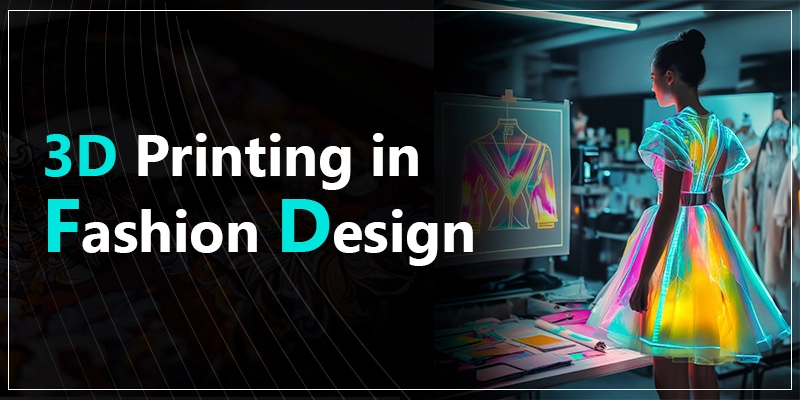
If you are looking for a career in the fashion industry, you must be aware of 3D printing and the techniques to incorporate 3D printing into your creative designs. 3D printing has revolutionised the fashion industry by providing creative freedom and efficiency to designers. This blog explains the impact and benefits of 3D printing and several methods to incorporate such attractive printing techniques while designing fashion garments. Let us dive in for further details.
How to Incorporate Fashion Innovation With 3D Printing?
Create Entire Garments
The 3D printing revolutionises the fashion industry by creating complex geometries that traditional textile methods cannot achieve. Designers can explore intricate shapes and experiment with organic forms, lattice structures, and personalised fits. This allows for a supreme level of creativity, which was previously unattainable. The 3D technology also allows the use of lightweight and flexible materials such as nylon, resins, and even bio-based polymers. This results in garments that are comfortable to wear and contribute to sustainability and shows a remarkable positive change in how we think about clothing design and production.
Produce Accessories and Footwear
The 3D printing offers a transformation to fashion and accessories as it enables a customized fit that caters to individual foot shapes and preferences. This technology eliminates the limitations of standard sizing and promotes a personalized experience and also reduces waste. It allows designers to create intricate details in items like jewelry, headwear, and eyewear as it infuses each piece with unique artistry and character. As a result, 3D printing enhances comfort and style and also promotes sustainability in the fashion industry.
Prototyping and Rapid Iteration
The 3D printing has transformed the design industry by speeding up the design process. It allows designers to quickly and efficiently make physical prototypes from digital designs. It supports an environment for swift iteration and experimentation, leading to faster product development cycles. The innovative technology can reduce prototyping costs by eliminating the need for expensive molds and machinery, making it a more accessible option for designers. Boston College provides degree and diploma programs for youngsters to launch their careers in the fashion industry.
Sustainable Practices
On-demand production through 3D printing revolutionizes manufacturing by eliminating the need for unnecessary large-scale production and significantly reduces inventory waste. This technology also facilitates local production, which cuts down transportation costs and lessens the overall environmental impact. Many 3D printing processes incorporate recycled materials, thus supporting sustainability and minimizing the environmental footprint of the fashion industry. Together, these advancements represent a significant step towards a more responsible and efficient approach to sustainable production.
Benefits Of 3D Printing in Fashion
Future of 3D Printing in Fashion
-
Sustainable Materials: The future will see a major shift towards more sustainable 3D printing materials, such as using bio-based polymers, recycled materials, and even materials derived from agricultural waste. This will make 3D-printed fashion more eco-friendly and reduce reliance on harmful chemicals.
-
4D Printing Integration: 4D printing, which involves materials that change their shape in response to external stimuli like temperature or light, will open up new possibilities for interactive and adaptive clothing. You can imagine garments that change colour, adjust according to temperature, or even repairs itself.
Future trends to look for with 3D Printing in Fashion Design
-
Integration with Wearable Technology: In the near future, 3D printing will be increasingly integrated with wearable technology and might allow for the creation of smart garments to monitor health, provide sensory feedback, and enhance performance.
Challenges in Incorporating 3D Printing Fashion Industry
The 3D printing technology presents both opportunities and challenges in the fashion industry. While the costs associated with this innovative method are showing a gradual decline, they are still above the affordable levels, which may deter some designers and brands from incorporating it. The availability of materials suitable for 3D printing in fashion remains limited. Another significant problem is the scalability of 3D printing, when it comes to mass production. Overall, while the potential of 3D printing in fashion looks promising, there are many other factors that still need to be addressed in order to be adopted worldwide.
To conclude, the 3D printing technology is changing the fashion industry in many ways, as it allows for more creativity, customization, and sustainability. It lets designers create complex shapes and detailed designs, and leads them to make unique and innovative clothing. This technology allows for the use of new materials, like biodegradable plastics and recycled materials, and promotes an eco-friendly approach to making clothes. Also, 3D printing supports on-demand production, which helps reduce waste and lessen the negative environmental effects of large-scale manufacturing. B.Sc Fashion Technology is a degree program that enables you to make a career for yourself in the fashion industry. As this technology develops, we can expect it to become even more common in fashion in the future, leading to highly personalized, sustainable, and advanced clothing options.